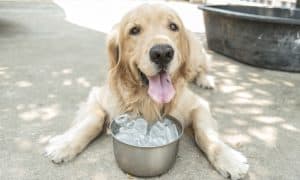“This post contains affiliate links, and I will be compensated if you make a purchase after clicking on my links.”
From vacations to barbecues and outdoor adventures, summertime means no worries for pets and pet parents — or so it seems. As it turns out, pets are 6% more likely to visit the vet unexpectedly during the summer compared to the rest of the year.

“While many pet owners are relaxing and having some fun in the sun, the summer season is no vacation for pets,” says Petplan staff veterinarian, Dr. Kim Smyth. “There are a number of common summertime hazards that can rain on your pet’s health, which could put a serious damper on your getaway fund and turn a trip to the beach into a trip to the vet.”
Pet parents need to be especially mindful of these top reasons pets visit the vet in the summer:
the heat is on: When the sun is high and temperatures climb, watch out for heat-related conditions like heat stroke, dehydration and heat rash – especially in brachycephalic breeds like Boxers, Bulldogs and Pugs. These snub-nosed pups are twice as likely to visit the vet for heat-related conditions than non-brachycephalic breeds. Signs of trouble include heavy panting, lethargy and a staggering gait. When the heat is on, be sure pets have plenty of fresh water and shade, and never leave them in a parked car.
beware the buzz: Painful encounters are bound to buzz pets when we share the outdoors with pesky, pointy insects. Pets are twice as likely to suffer an insect sting during the summer compared to the rest of the year, and bees are to blame for 25% of these incidents. Stings can cause mild symptoms like redness and swelling, as well as more serious reactions like anaphylaxis (allergic shock), which requires immediate veterinary attention. Symptoms of anaphylaxis include difficulty breathing and vomiting.
skin deep: Pay special attention to your best friend’s skin, because the risk of skin infection is 16% higher during summer months. Common causes include allergies, extra moisture from swimming or humidity and pests like fleas. Look for itchy, irritated skin or lesions, and keep an eye out for extra scratching or licking that could indicate an issue.
grapes of wrath: Refreshing as they may be, keep grapes (and raisins!) out of paws’ reach – vet visits for grape and raisin toxicity are 40% higher during the summer. The average cost to treat grape and raisin poisoning is $756, but one Petplan-protected pup faced a hair-raising vet bill of $3,035! These fruits can cause acute kidney failure if ingested, and signs include vomiting, increased thirst and diarrhea. Call the vet right away if you suspect your four-legged vacuum swiped up a grape or anything grape-related, such as wine or oatmeal raisin cookies.
gobbling cobs: Corn on the cob is a barbeque staple, and some pets try to take this side to-go. Corn cob ingestions are seven times more likely in the summer than the off-season, with 70% of all corn cob ingestions occurring between June and August. Corn cobs can get lodged in a dog’s intestines or stomach if eaten, which sometimes requires surgery to remove it. Clear plates at the end of dinner and keep trash bags contained so they don’t tempt the resident chow hound.
Pet parents can step in to help ensure furry friends have a safe, sunny season. “Even during the dog days of summer, pay attention to how your pet acts and feels and know what’s normal for them. If they show signs of anything unusual, take a trip to your vet. You’ll both be back to lounging poolside in no time,” says Smyth.
For protection against the unexpected over the summer (and year-round!), visit www.petplan.com to learn more about Petplan pet insurance.


















